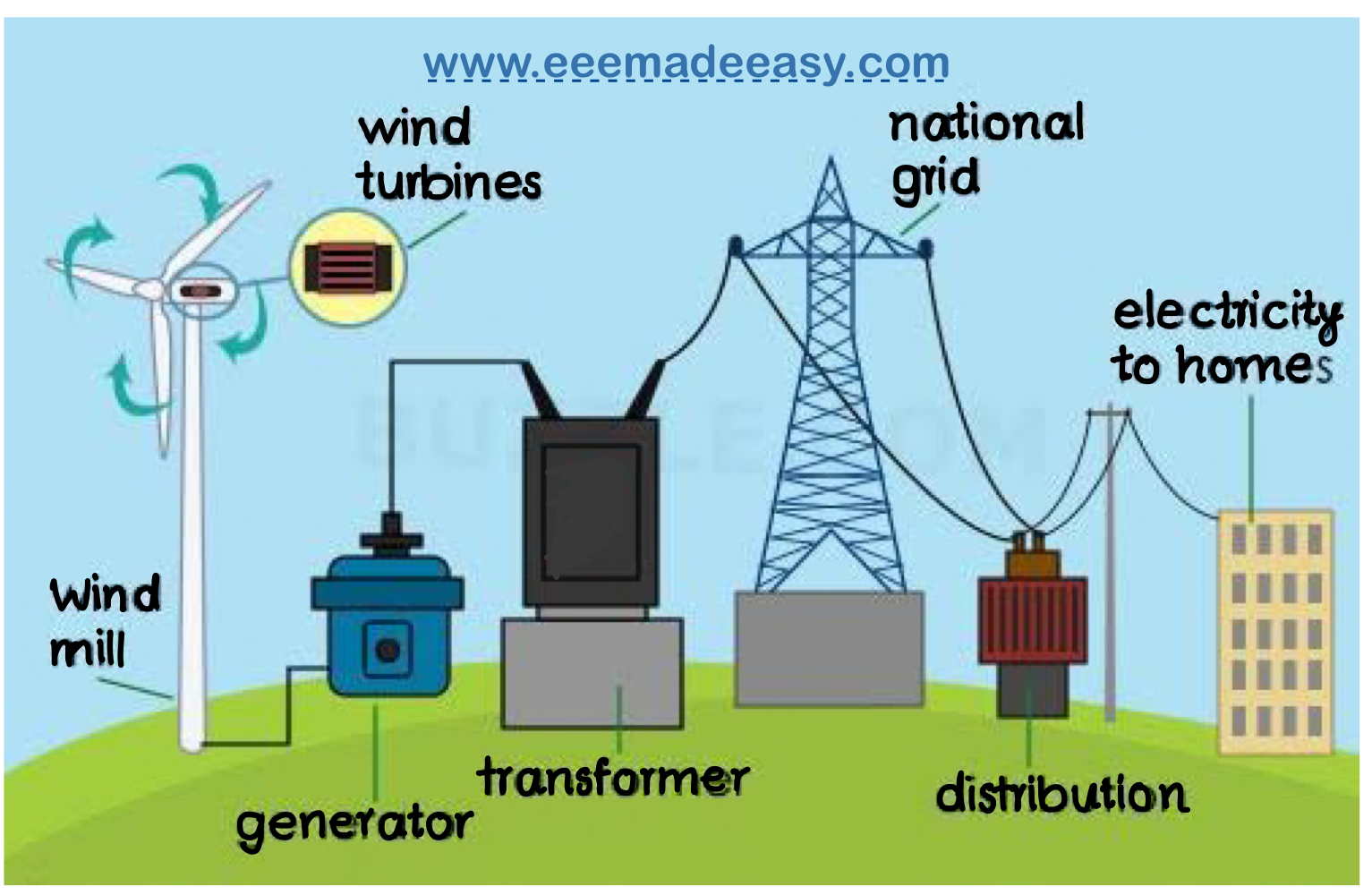What is Wind Power or Wind Energy ?
Wind power or wind energy is the use of wind to provide mechanical power through wind
turbines to operate electric generators.
Wind power is sustainable and renewable energy.
Wind possesses energy by virtue of its motion.
Any device capable of slowing down the mass of moving air, like a sail or propeller, can extract part of the energy and convert it into useful work.
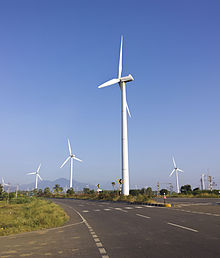
The spinning blades, attached to a hub and a low-speed shaft, turn along with the blades.
The rotating low-speed shaft is connected to a gearbox that connects to a high-speed shaft on the opposite side of the gearbox.
This high-speed shaft connects to an electrical generator that converts the mechanical energy from the rotation of the blades into electrical energy.
key characteristics of a good wind power site
The key characteristics of a good wind power site are high average wind speed, sufficient
separation from noise-sensitive neighbors, good grid connection, good site access, and No special
environmental or landscape designations.
Challenges of Integration of Wind in to grid
The integration of wind into the grid has certain challenges like Variability, Uncertainty, Location-specificity, Nonsynchronous generation, and Low capacity factor.
Wind Energy Basics
Wind energy is a form of solar energy. How?
The wind is caused by the uneven heating of the atmosphere by the sun, variations in the earth’s surface, and rotation of the earth.
Mountains, bodies of water, and vegetation influence wind flow patterns. Wind speeds vary based on geography, topography and season.
As a result, there are some locations better suited for wind energy generation.
Wind power is the conversion of wind energy into electricity or mechanical energy using wind
turbines.
Wind turbines convert the kinetic energy in the wind into mechanical power.
A generator can convert mechanical power into electricity.
Mechanical power can also be utilized directly for specific tasks such as pumping water.
The mechanism used to convert air motion into electricity is referred to as a turbine.
The power in the wind is extracted by allowing it to blow past moving blades that exert torque on a rotor.
The rotor turns the drive shaft, which turns an electric generator.
The amount of power transferred is dependent on the rotor size and the wind speed.
Windmills
People have been using windmills for centuries to grind grain, pump water, and do other work.
Windmills generate mechanical energy, but they do not generate electricity.
Windmills have been in use since 2000 B.C. and were first developed in Persia and China. Ancient mariners sailed to distant lands by making use of winds.
Farmers used wind power to pump water and for grinding grains. Today the most popular use of wind energy is converting it to electrical energy to meet the critical energy needs of the planet
Wind Turbines
In contrast to windmills, modern wind turbines are highly evolved machines with more than 8,000 parts that harness wind’s kinetic energy and convert it into electricity.
Wind farm
Oftentimes a large number of wind turbines are built close together, which is referred to as a
wind project or wind farm. A wind farm functions as a single power plant and sends electricity to the grid.
In old Wind-mills, wind velocity is directly used for performing the jobs such as wheat-grinding, pumping water for irrigation, sailing vessels, etc.
It enjoys the advantages of being plentiful, inexhaustible, renewable and non-polluting, over and above being cheap for running costs.
It suffers from the disadvantages of being unreliable, and being economically un-viable for large power generation.
In India, a large number of such units with small and medium power ratings (up to 100 kW) are already in operation mainly in coastal or hilly areas.
With the modern system, it is now preferred to have suitable power control circuits on the output side of wind-generators so that these can pump energy into low voltage lines of the grid over a wide range of variation of wind speeds.
A large variety of wind turbines naturally exist arising out of large variations in wind-pattern Wind-generation
Schematic view of Wind power
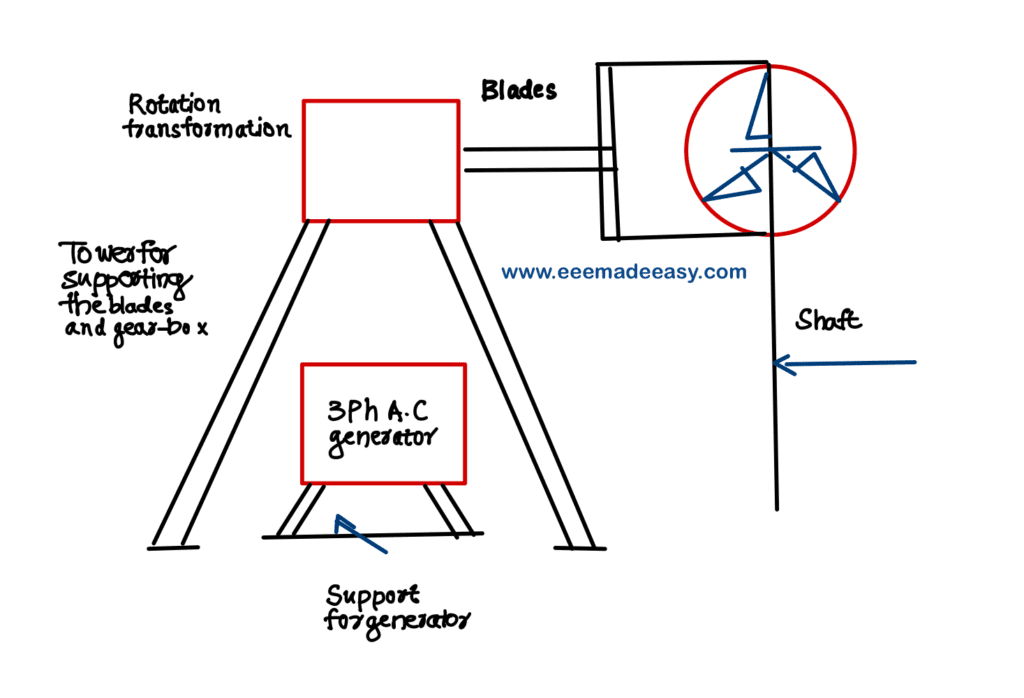
In Fig. an arrangement wherein, a horizontal three-bladed system is shown mounted on a tower. Through rotation transformation using gears to step up the speed and to link the horizontal axis of turbine with vertical axis of generator.
The speed of wind varies, as such turbine speed also varies so that output frequency and voltage of three-phase alternator vary over a wide range.
Further, its waveform is also a distorted one. To increase its utility, it is necessary
to modulate (through proper power control) to derive line-frequency constant voltage output and
hook-up to local grid for pumping the available wind energy into it. This is schematically represented in fig below.
Part-side-view to show a typical three-bladed wind turbine
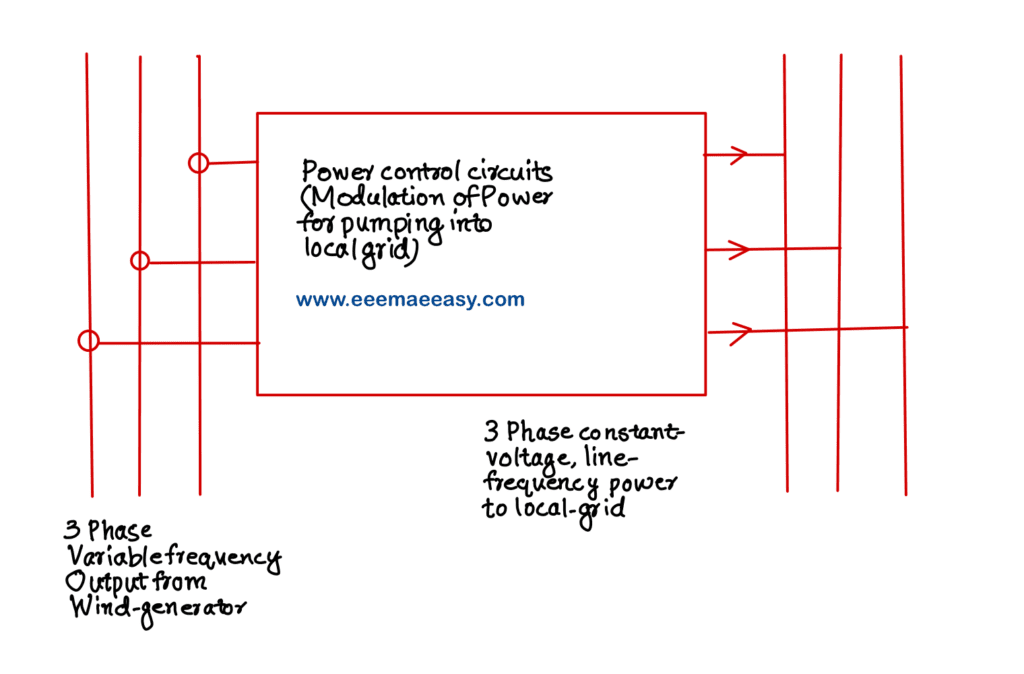
Wind farms have been located where a large number of wind generators of ratings of few
hundred kilowatts are in operation.
For every unit, there is a safe wind – speed zone.
If the wind-speed is below this, there is no appreciable power output, hence, it is better that the system is not brought into operation.
If the wind speeds are too high, it is mechanically unsafe and hence it is not to be operated, even if the energy available is higher.
This is decided by automated system.
Such forms are located in coastal regions and in hilly areas.
Because of the metering of energy received by the local grid, the investor can get a good return through payment from the grid-authorities.
Hence, this has become a medium-level and attractive industrial investment.
Wind power in India
The development of wind power in India began in the 1990s, and has significantly increased in the last few years.
As of 30 September 2022, the total installed wind power capacity was 41.666 GW, the fourth largest installed wind power capacity in the world.
Wind power capacity is mainly spread across the Southern, Western, and Northwestern states
Wind power accounts for 10% of India’s total installed power capacity.
wind-solar hybrid policy
The Indian Government’s Ministry of New and Renewable Energy announced a new wind-solar hybrid policy in May 2018.
This means that the same piece of land will be used to house both wind farms and solar panels.
Largest wind farms in India
As of 30 June 2018 the installed capacity of wind power in India was 34,293 MW mainly spread across Tamil Nadu (7,269.50 MW), Maharashtra (4,100.40 MW), Gujarat (3,454.30 MW), Rajasthan (2,784.90 MW), Karnataka (2,318.20 MW), Andhra Pradesh (746.20 MW) and Madhya Pradesh (423.40 MW).
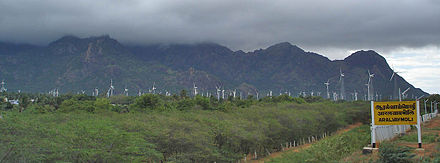
Wind farms in Kerala
55 MW production of wind power is installed in Kerala. The first wind farm of the state was set up in 1997 at Kanjikode in the Palakkad district.
The largest wind turbine in the world is located in US in Hawaii. It stands 20 stories tall and has
blades the length of a football field.
Wind energy characteristics
Wind energy is a special form of kinetic energy in air as it flows.
Wind energy can be either converted into electrical energy by power-converting machines or directly used for pumping water, sailing ships, or grinding grain.
Three key factors affect the amount of energy a turbine can harness from the wind: wind speed, air density, and swept area.
Most of the modern wind turbines have 3 blades which can reach speeds at the tip of over 320 kph (200 mph)
Wind power
Kinetic energy exists whenever an object of a given mass is in motion with a translational or
rotational speed. When air is in motion, the kinetic energy in moving air can be determined as
E = 1/2 mu^2
where m is the air mass and u is the mean wind speed over a suitable time period.
The wind power can be obtained by differentiating the kinetic energy in wind with respect to time
Types of Wind Power Plants (WPPs)
A wind power plant is simply a collection of wind turbines in one area. There are several different
types of wind power plants.
The following classification is based on their construction, size and usage.
Remote Wind Power Plants
Areas that are remote but are blessed with good wind speeds and frequency need a wind turbine
which is maintenance-free or low-maintenance for long periods of time (just imagine a service technician rushing across mountains and valleys on foot or bullock-cart to repair a turbine time and again).
This means that they should have the capability of standing against all odds of climate even if they are relatively smaller in size than their conventional counterparts.
These types of turbines are known as remote wind power turbines and are specifically designed with these objectives in view.
Hybrid Wind Power Plants
Wind is not fully reliable so we cannot depend on wind alone for generation of power. The best bet
would be to combine a wind power plant with some other renewable source of energy, like solar energy.
That would be certainly a better idea and you can imagine that when there is a lot of heat, the solar generators would do their job and when the sky is overcast and winds are blowing, the wind power plants would take over.
Such an arrangement is known as hybrid arrangement and is useful in regions where there
is a lot of heat and wind.
Grid-Connected Wind Power Plants
This concept is similar to a hybrid system. The wind power plant is used in conjunction with a main
grid that supplies most of the power.
The main purpose of wind turbines is to supplement the energy supply for the grid, whereas the main function in the hybrid system is to complement the energy supply, hence the minor difference in the set up.
Wind Farms
As the name itself suggests, a wind farm is a collection of wind turbines which collectively power a
given area or utility harnessing the wind force in a collective manner thereby amplifying the effect of a single unit.
These configurations are used at various locations depending on the conditions of the region and the presence of other sources of electrical supply. An optimum mix would consist of an ingenious combination of the various sources in the best possible manner.
Types of wind power plants based on capacity
The types of wind power plants based on capacity are;
Utility-scale wind: Wind turbines that range in size from 100 kilowatts to several megawatts, where the electricity is delivered to the power grid and distributed to the end user by electric utilities or power system operators.
Distributed or “small” wind: Single small wind turbines below 100 kilowatts that are used to
directly power a home, farm or small business and are not connected to the grid.
Offshore wind: Wind turbines that are erected in large bodies of water, usually on the continental
shelf. Offshore wind turbines are larger than land-based turbines and can generate more power.
Types of wind turbines
Wind turbines can be separated into two basic types determined by which way the turbine spins.
Wind turbines that rotate around a horizontal axis are more common (like a wind mill), while vertical axis wind turbines are less frequently used (Savonius and Darrieus are the most common in the group).
- Industries Extension Officer Syllabus Kerala PSC|IEO 2024 Syllabus
- [PDF]Trade Instructor Gr.II Electroplating Syllabus Kerala PSC|92/2023 syllabus
- [PDF] Syllabus Assistant Engineer Electrical Harbour Engineering Kerala PSC
- Industries Extension Officer Kerala PSC Notification|IEO 2024
- Electricity Act 2003 Section 135
